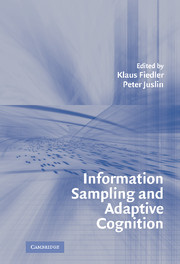Book contents
- Frontmatter
- Contents
- List of Contributors
- PART I INTRODUCTION
- 1 Taking the Interface between Mind and Environment Seriously
- PART II THE PSYCHOLOGICAL LAW OF LARGE NUMBERS
- PART III BIASED AND UNBIASED JUDGMENTS FROM BIASED SAMPLES
- PART IV WHAT INFORMATION CONTENTS ARE SAMPLED?
- PART V VICISSITUDES OF SAMPLING IN THE RESEARCHER'S MIND AND METHOD
- Index
- References
1 - Taking the Interface between Mind and Environment Seriously
Published online by Cambridge University Press: 02 February 2010
- Frontmatter
- Contents
- List of Contributors
- PART I INTRODUCTION
- 1 Taking the Interface between Mind and Environment Seriously
- PART II THE PSYCHOLOGICAL LAW OF LARGE NUMBERS
- PART III BIASED AND UNBIASED JUDGMENTS FROM BIASED SAMPLES
- PART IV WHAT INFORMATION CONTENTS ARE SAMPLED?
- PART V VICISSITUDES OF SAMPLING IN THE RESEARCHER'S MIND AND METHOD
- Index
- References
Summary
Metaphors mold science. Research on judgment and decision making (JDM) – for which psychologists and economists have gained Nobel prizes (Kahneman, Slovic & Tversky, 1982; Simon, 1956, 1990) and elevated political and public reputations (Swets, Dawes & Monahan, 2000) – is routinely characterized as having proceeded in several waves, each carried by its own metaphor. A first wave of JDM research in the 1960s compared people's behavior to normative models, a common conclusion being that, with some significant exceptions, human judgment is well approximated by normative models (Peterson & Beach, 1967): The mind was likened to an “intuitive statistician” (a metaphor borrowed from Egon Brunswik).
A second and more influential wave of JDM research, initiated by Tversky and Kahneman, emphasized the shortcomings, biases, and errors of human judgments and decisions (Kahneman et al., 1982). Because of the mind's constrained capacity to process information, people can only achieve bounded rationality (Simon, 1990), and – as inspired by research on problem solving (Newell & Simon, 1972) – they have to rely on cognitive heuristics. In contrast to problem-solving research, however, the focus was on heuristics leading to bias and error in judgment. The metaphor of an intuitive statistician was soon replaced by the notion that the mind operates according to principles other than those prescribed by decision theory, probability theory, and statistics. In the fond lurks Homo economicus, a rational optimizer with gargantuan appetite for knowledge, time, and computation defining the norm for rational behavior.
- Type
- Chapter
- Information
- Information Sampling and Adaptive Cognition , pp. 3 - 30Publisher: Cambridge University PressPrint publication year: 2005
References
- 3
- Cited by



